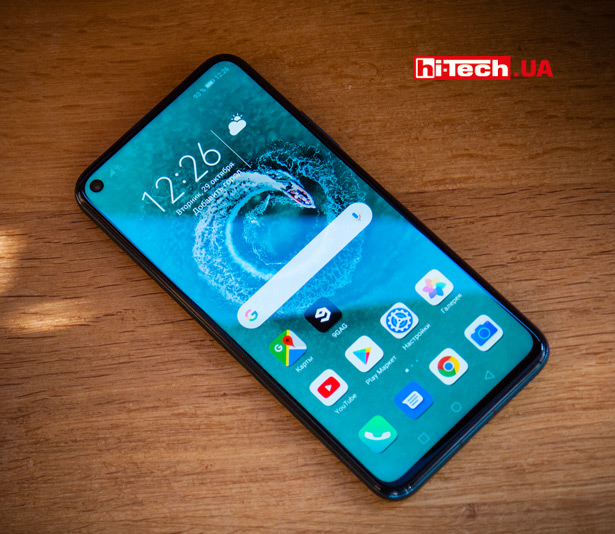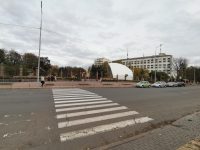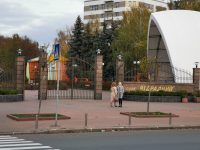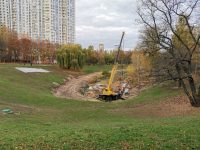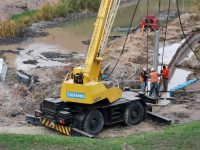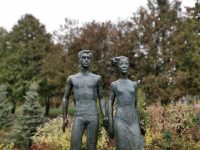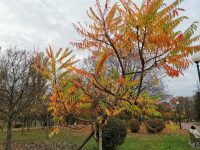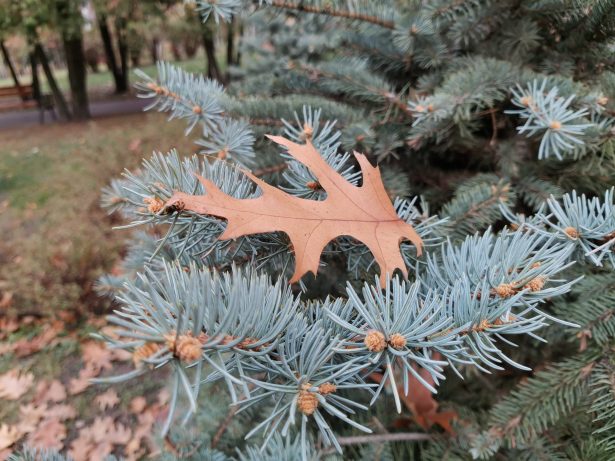Honor 20 Pro smartphone review. Cheaper flagship model?
01.11.19
Smartphone Honor 20 Pro
Under the Honor brand, owned by Huawei, the company produces smartphones and other mobile devices that are more targeted at a youth audience.
For those who are at least somewhat interested in gadgets, this information is not something new, but we nevertheless decided to remind you about it once again.
Honor 20 Pro is currently the top-end smartphone of the Honor brand. The global announcement of the model took place in May of this year, and the 20 Pro has been available in our market since approximately August.
From his brother Honor 20 (without the prefixPro) it is distinguished mainly by an additional camera module, a larger amount of memory and a slightly increased battery capacity.
If we talk about cost, then Honor 20 Pro is approximately on the border between the middle and high classes of smartphones.
Honor smartphones usually have a very good ratio of capabilities to price. How did it turn out this time?
External inspection and equipment
In accordance with trends, the manufacturer tried to “fill” the entire front panel with the screen.
You can see the display frames in the photo.
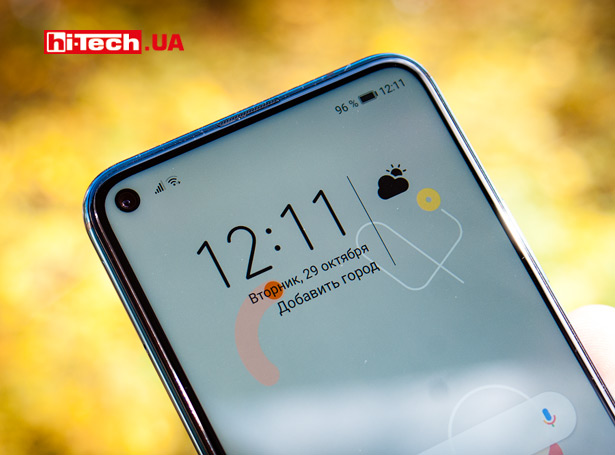
A special round cutout was made for the front camera, which was placed in the corner. A similar solution can be seen in smartphones of the line Samsung Galaxy S10.
Despite the fact that the top of the screen is extended almost to the edge, the earpiece here is traditional (placed on the edge of the body), and not built into the screen itself, as for example in the Huawei P30 Pro.
An information LED was placed under this thin speaker grille.
As you would expect from a high-end smartphone, an all-metal frame design is used. The back panel is glass
The quality of materials and level of workmanship deserve only praise.
20 Pro is available in several color options, but for the Ukrainian market there is only one color version. In the official press release, the manufacturer calls this color emerald. And on the English-language website it is listed as Phantom Blue.
According to the manufacturer, Triple 3D Mesh dynamic holography technology is used on the back, which allows the rear glass to shimmer under the rays of light.
The appearance of the case depends on the lighting. In a series of photographs you can see the effects that are produced.
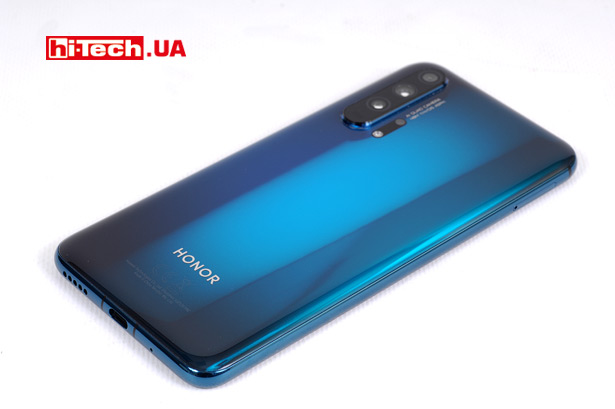
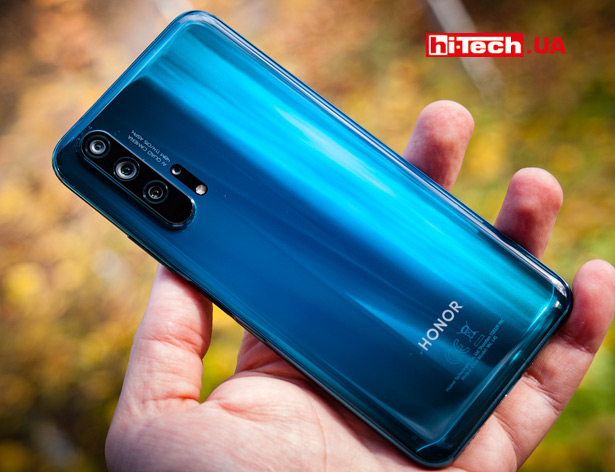
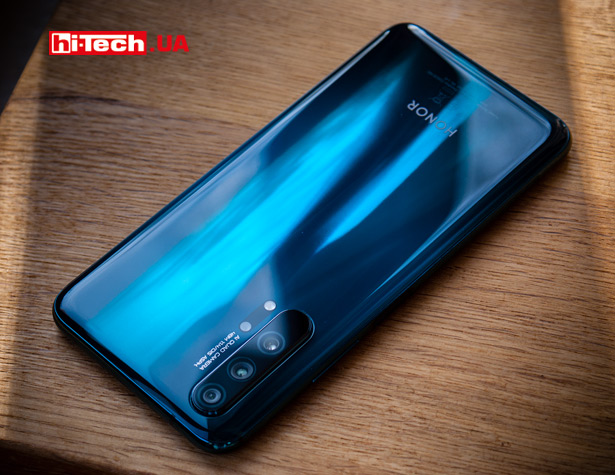
On one side there is a slot for two SIM cards. Yes, you can’t install a memory card here. On the other side there is a power button with a built-in fingerprint sensor and a volume rocker.
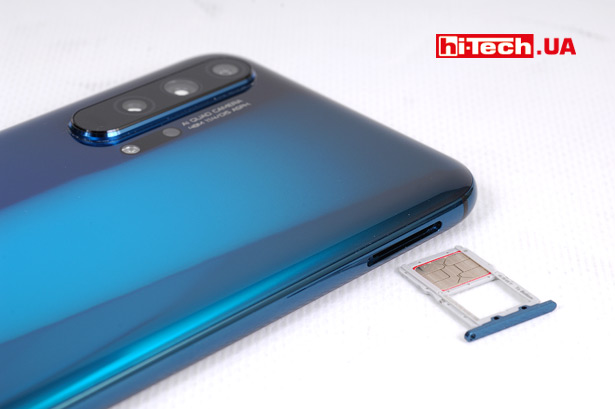

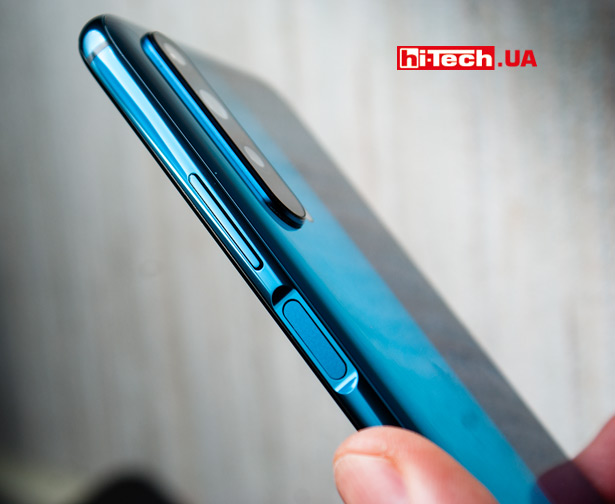
The fingerprint sensor is built into the power button of Honor 20 Pro
At the top you can see the hole for an additional microphone and a proximity sensor.
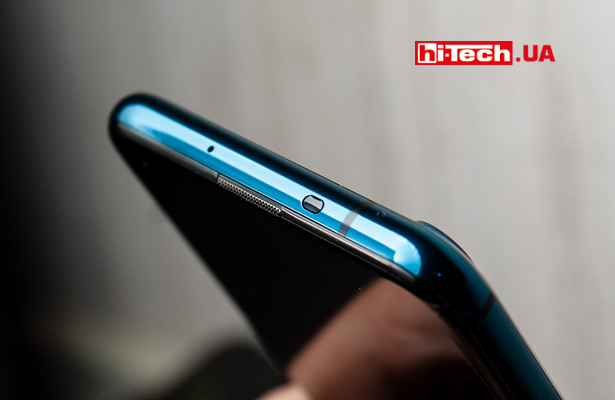
In appearance, many people confuse this sensor with an infrared port (for controlling household appliances), but there is no infrared emitter here.
There is only one multimedia speaker. It is installed at the bottom and adjacent to the USB-C interface port.

There is no standard 3.5mm headphone/headphone output here. It’s a pity that this trend is affecting more and more modern devices.
This drawback is partially compensated by the presence of an adapter included in the kit.

The box also contains documentation, a SIM card tray ejector, a charger with a USB cable, and a protective bumper.
This bumper is quite simple, but it’s nice to see such a bonus.
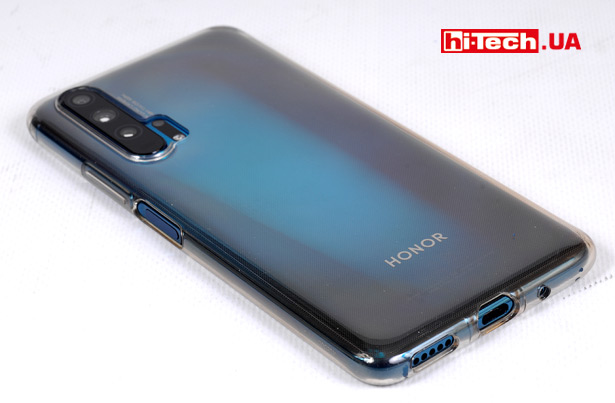
Honor 20 Pro with transparent protective bumper
Those who like to apply protective films will also like the fact that the Honor 20Pro comes with such a protective film already from the factory.
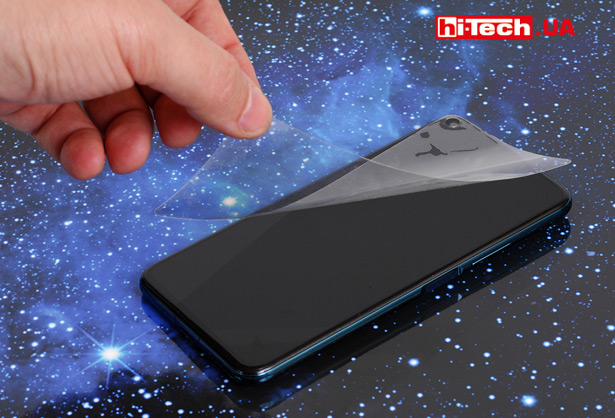
On the back, of course, an advanced camera with four (!) shooting modules attracts a lot of attention. I will tell you more about these modules and shooting capabilities separately.
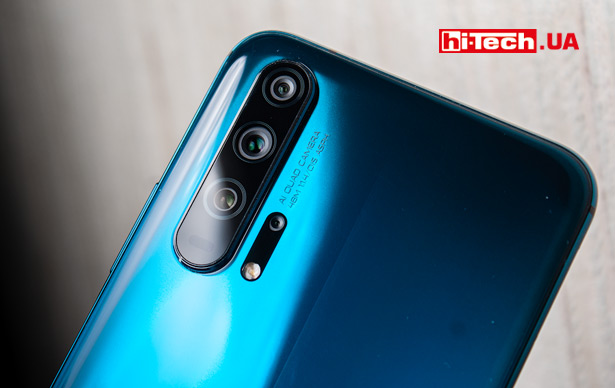
The chamber block protrudes noticeably beyond the body.
Screen and proprietary Magic UI shell
The installed screen with a diagonal of 6.26” has a resolution of 2340×1080 pixels. It’s a good ratio of size to resolution. The aspect ratio is 19.5:9.
The type of matrix used is IPS. Today, some will prefer an AMOLED screen, but I wouldn’t say that using IPS is any disadvantage.
The smartphone has a good reserve of brightness and wide viewing angles.
There are also various menu items for adjusting color rendering if you don’t like the standard option.
Although at the time of preparation of the material there were already announcements that the Honor 20 Pro would receive the new Android 10 firmware, I had not received this update yet and the smartphone was running Android 9 with the proprietary Magic UI 2.1.0 shell.
A similar shell is used on Huawei smartphones.

Оболочка Magic UI 2.1.0
Magic UI 2.1.0 does not require long-term adaptation.
There is a “normal” control option with on-screen menu buttons, as well as a gesture control option that is reminiscent of the controls on the new iPhones.
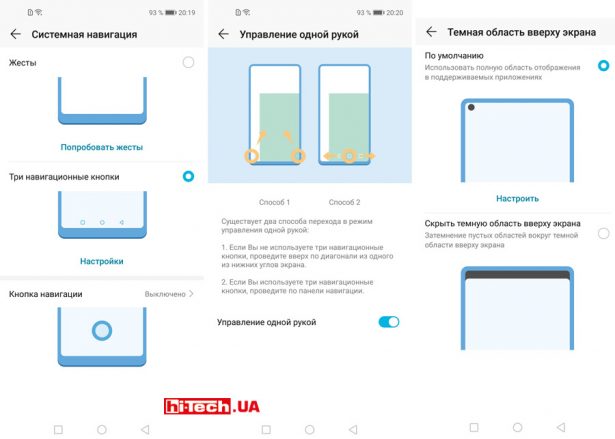
Shortcuts for all applications are initially distributed across desktop pages. But, if you are used to calling up the list of applications with a separate button, and keeping only shortcuts of the most necessary applications on the home screen, this is also available.
Overall, I liked the default SwiftKey keyboard. I even decided not to change it to the more familiar Google Gboard.
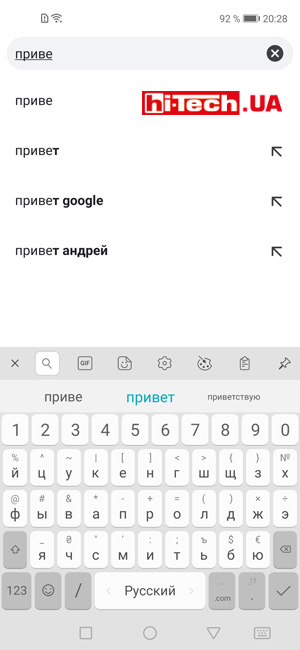
Pre-installed SwiftKey keyboard
In the menu you can find various functions familiar to Magic UI shells, such as screen recording, various gestures, displaying the current Internet data transfer speed, a cover manager, a set of proprietary applications, etc.
Impressions
In a couple of weeks of using the Honor 20 Pro as my main smartphone, I did not encounter a single error or freeze.
The smartphone worked stably and without problems.
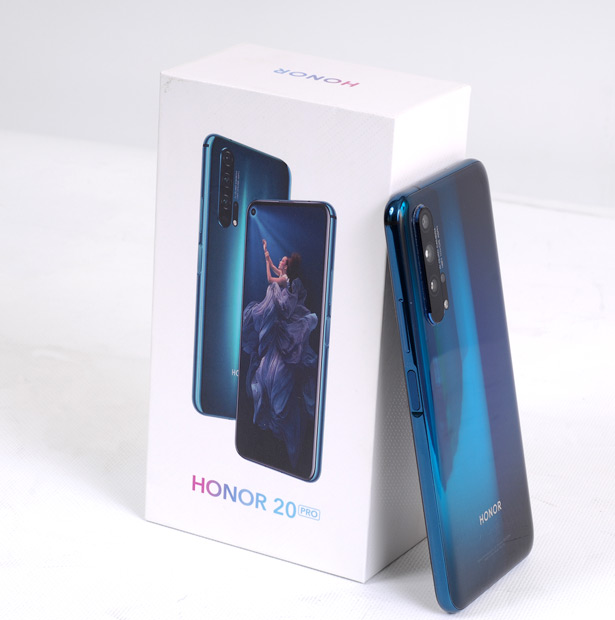
The audibility of the conversational speaker is excellent, there are no complaints about the work of the built-in microphones.
The screen capabilities are enough even for very demanding users. Of course, there are plenty of high-end smartphones with brighter screens or higher resolutions, but in this case, the Honor 20 Pro’s display is reasonable sufficiency.
Honor 20 Pro is not a giant in size, as for a modern smartphone, although the device turned out to be quite massive.
It is now fashionable in high-end smartphones to install a fingerprint sensor under the screen itself.

But I would consider the placement of the fingerprint sensor on the power button in the Honor 20 Pro as an advantage. This method is convenient, works reliably and very quickly.
At the moment, specific optical or ultrasonic fingerprint sensors installed in high-end smartphones directly on the screen are inferior in terms of convenience or speed.
It is possible to unlock the Honor 20 Pro smartphone using the face. The mode, however, turned out to be relatively simple. There is no infrared illumination with 3D head detection.
Even the manufacturer separately warns that face detection can be faked, and the quality of detection greatly depends on the lighting and how covered the face is with clothing or glasses.

Personally, I preferred the fingerprint sensor with its excellent performance over the face unlock in this model.
With such a built-in storage of 256 GB, the absence of a memory card slot can hardly be called a blessing.
But the lack of a headphone output was not encouraging. Considering the youth orientation of the Honor brand, there will probably be many users who want to connect their wired headphones directly, and not through an adapter.

The wire in the adapter for connecting headphones is quite thin, which may affect its service life during intensive use.
The multimedia speaker did not surprise us with anything special, but at the same time it has a good volume reserve and plays, in general, well.
The smartphone is very responsive and fast in operation. The device, as they say, just flies :).
An impressive 8 GB of RAM allows you to store a large number of open applications in memory without compromising the comfort of your work.
Performance, battery and charging
The Honor 20 Pro is powered by Huawei’s proprietary HiSilicon Kirin 980 processor. This processor is found in all top and flagship smartphones from Huawei and Honor, presented from the end of last year until mid-autumn 2019.
Before the release of HiSilicon Kirin 990 in early September, the Kirin 980 processor was the most advanced and powerful in the Huawei line.
Honor 20 Pro is not a performance champion. Looking at the benchmark results, many smartphones powered by Snapdragon 855 processor score higher.
But, nevertheless, this is a very fast smartphone whose capabilities are easily enough for demanding games.

By the way, when you activate the “productive” mode, you can achieve a performance increase of up to 10% (the screenshots show the results of the AnTuTu and 3DMark tests in normal and “productive” modes).

The temperature conditions of the 20 Pro are in perfect order. Even when using stress tests and games, the processor temperature did not even come close to any unsafe limits.
This is probably due to the energy-efficient processor and cooling system.
In terms of battery lifeHonor 20Pro showed excellent results.
With a 4000mAh battery, you can expect several days of battery life with moderate use.
And with a very intense load, the charge should be enough for the whole day.
By the way, the proprietary Magic UI shell traditionally pays a lot of attention to energy efficiency and cost-effectiveness.
If the system detects an application with high energy consumption, you receive information about this, various battery operating modes are provided, etc.
Screen resolution can be reduced to increase battery life.
I also ran the Honor 20 Pro in a special PCMark test simulating a moderate load. The screen in this test is always on. With the brightness set to about 30% the smartphone was able to work for 15 hours. This is an excellent indicator for this test

Honor 20 Pro battery life in PCMark test
The kit comes with a fairly high power charger of 22.5 W, which provides faster charging. In half an hour, Honor 20 Pro reaches approximately 50% of its battery capacity, and a full charge lasts approximately 1 hour 40 minutes.

When studying the characteristics of the power supply, an interesting detail is discovered. Accelerated charging technology is implemented here without increasing the voltage. As a result, the current is quite large.
This places increased demands on the quality of the USB cable used. Not with every USB cable you can charge the Honor 20 Pro as quickly as with its included cable.
Cameras and filming
Understanding the configurations of multi-module cameras on modern smartphones is sometimes not so easy. Depending on the manufacturer and model of the device, the options can be very diverse.
In this case, a camera with four modules is installed on the rear panel.

Three large modules are clearly visible, and the fourth, smallest, is located next to the flash.
I will describe the modules separately.
- Main camera A lens with a wide viewing angle and the highest aperture ratio F: 1.4 is used (the lower the value, the higher the aperture). Equivalent focal length 28 mm.
A large Sony IMX586 matrix (sensor) with a resolution of 48 megapixels is installed. standard size 1/2″.
Optical stabilization system is supported.
- Ultra-wide-angle camera. Lens with an equivalent focal length of 13 mm (viewing angle 117°). Aperture – F: 2.2.
A 16-megapixel 1/3.1″ sensor is installed.
- Telephoto camera (3x zoom). Lens with an equivalent focal length of 80 mm. The lens aperture is F: 2.4. An 8-megapixel 1/4.4″ sensor is used
Optical stabilization system is supported.
- Camera for macro photography. 2 megapixel camera with fixed focus. Lens with aperture F:2.4.

The first three cameras are the currently traditional option, when in addition to the main one a module with wider and narrower viewing angles is added.
Comparison of view catch when shooting with ultra-wide-angle (0.6x zoom), main (1x zoom), tele (3x zoom) cameras and using 5x hybrid zoom
The presence of an additional small camera for macro photography looks somewhat strange. It has a very low resolution, the sensor itself is small. When shooting in good conditions, the quality is quite sufficient for viewing on mobile device screens. But don’t have high hopes for this module.
Macro Mode
- Снимок, полученный 2-мегапиксельной макрокамерой
- Снимок, полученный 48-мегапиксельной основной камерой
It’s hard to say why she even appeared here. This may be due to the fact that with the main module, due to the high aperture ratio and large sensor, it was difficult to ensure autofocus at a short distance (several centimeters).
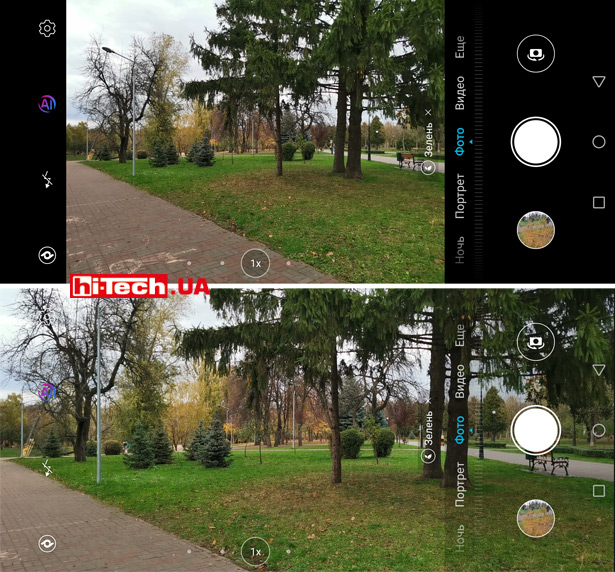
Camera interface
The main camera, traditionally for smartphones, stands out compared to other modules both in terms of shooting quality and functionality.
It is based on the very popular Sony IMX586 sensor. This 48-megapixel sensor can be seen in many new high-end smartphones.
The technology of combining four adjacent pixels into one is used. As a result, you get 12-megapixel photos at the output.
For experiments, you can also set the full resolution mode for 48 megapixel photos, but this does not add detail to the pictures.

In camera mode, you can zoom using a virtual slider. In this case, there is a switch between three modules depending on the current scaling.
A separate selection of cameras is also available.
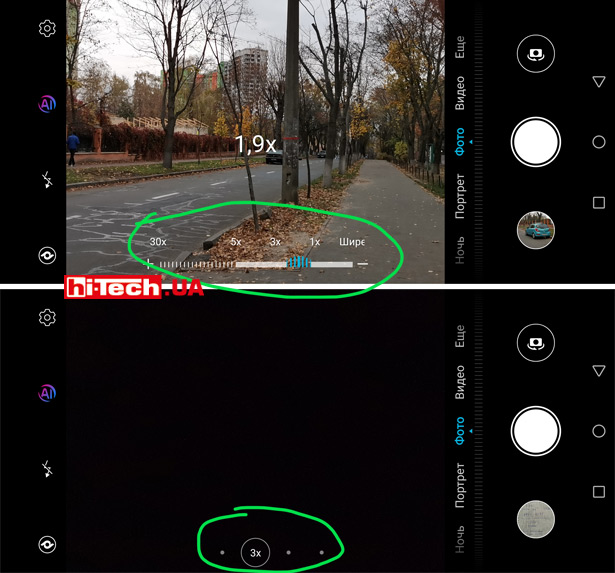
The ratio of the focal lengths of the main and television cameras is approximately 3. Hence the designation 3x zoom.
You can zoom even further, using a combination of digital zoom and various technologies associated with computational photography. This applies to both photo and video shooting.
Under favorable shooting conditions in terms of lighting, all three modules are capable of demonstrating a good level. But the more difficult the conditions, the more advantageous the results from the main camera will look.
When there is a significant lack of lighting, the body camera is not used at all; instead, the main one works with cropping of the frame.

Additional shooting modes

AR-emoji
I was very pleased with the quality of artificial background blur in Honor 20 Pro. The mode should appeal to many. By the way, it can be used not only for portraits, but also for highlighting various objects.
- With blur
- Without blur
At the same time, the super slow motion mode at 960 fps turned out to be quite “weak”. Firstly, the quality of the recordings is very low, and secondly, for experienced users experimenting with slow motion -shooting, the effect of artificially adding frames will be noticeable. It looks like there is no real 960 fps speed here.
4K videos are highly detailed. The maximum recording speed in this mode is 30 fps. I would, of course, like to see the ability to shoot 4K 60 fps, but this function is currently only available in the highest level smartphones.
For photo mode, you can separately activate the AI shooting function (artificial intelligence). The bottom line is that, based on technologies related to artificial intelligence, which are supported at the hardware level in the processor itself, the scene being photographed is determined (autumn leaves, clouds, snow, sunset, flowers, etc.) and the photo is subjected to additional processing.

Basically, this processing involves selectively increasing the saturation of various colors and changing the color balance.
The function is interesting, but if you like to post-process frames yourself, it is better to disable it.
The combination of advanced optical and electronic stabilization allows you to shoot quite successfully at night without a tripod, and also helps you get smooth videos.
There is also a trendy separate night photography mode. For comparison, it is better to view the pictures in their original size.
- Night photo by hands
- Night photo with night mode
For those who like to experiment, a “professional” mode is available with the ability to manually set many parameters, including sensitivity, shutter speed, etc. d. In the same mode, shooting in RAW format is available.
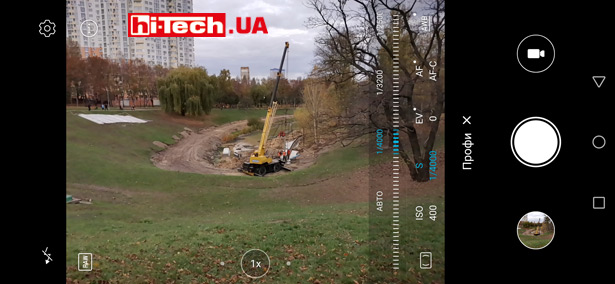
“Professional” shooting mode of Honor 20 Pro with the ability to manually adjust parameters
To summarize, I would say that the Honor 20 Pro cameras provide the widest field for experimentation with photo and video shooting.
In addition, this is supported by the very decent quality of the resulting personnel.
The camera is one of the strengths of this smartphone.
Gallery of images taken with the Honor 20 Pro camera
Conclusions
To answer the question asked in the title, the Honor 20 Pro is still not a competitor to the top category of devices such as the Samsung Galaxy S10 series, Huawei P30 Pro, etc., although in a number of parameters, for example, the amount of RAM and storage, the processor used , body materials, is on an equal footing with them.
The Honor 20 Pro in question is a very strong player in the advanced mid-range smartphone segment.
There are many competitors here, however, we consider the Honor 20 Pro an attractively priced option, given the model’s capabilities.
In terms of characteristics, Honor 20 Pro is in many ways similar to its relative Huawei P30, but is noticeably more affordable.
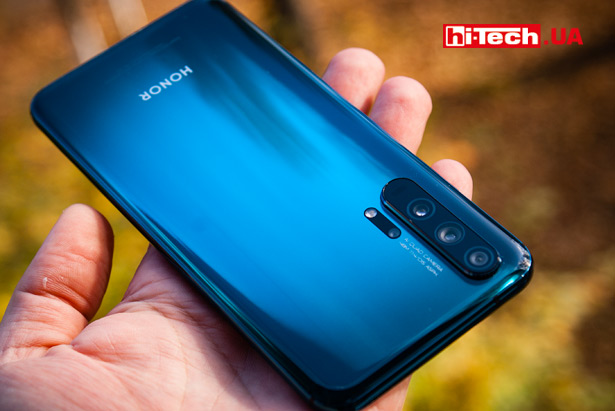
The smartphone turned out to be truly balanced.
It takes great pictures and has good performance coupled with long battery life.
Let’s not forget about the impressive memory reserves.
Unfortunately, the manufacturer decided to transfer some not very pleasant modern trends here. First of all, this is the lack of an analog headphone output.
Characteristics of Honor 20 Pro |
|
| Screen | 6.26″, 19.5:9, IPS |
| Screen resolution | 2340×1800 px. |
| Operating system | Android 9 + Magic UI 2.1.0 |
| Rear cameras | 48 megapixels. (main), 8 megapixels. (telephoto camera), 16 MP (ultra-wide-angle), 2 MP (macro) |
| Selfie camera | 32 megapixels. |
| Processor | HiSilicon Kirin 980 |
| RAM capacity | 8 GB |
| Internal memory | 256 GB |
| Card reader | no |
| Dual SIM support | yes (nano-SIM) |
| Interfaces | Bluetooth 5.0, USB 2.0, Wi-Fi a/b/g/n/ac, NFC |
| GPS receiver/gyrosensor/light sensor | yes/yes/yes |
| FM radio/IR transmitter | no/no |
| Battery capacity | 4000 mAh |
| Dimensions | 154×74×8.34 mm |
| Weight | 182 g |
| Supplier | Honor representation |
| Price: | 14,000 UAH ($560) |
Rating:
+ shooting quality, camera functionality
+ good performance
+ battery life
+ large amount of RAM and capacious storage
+ excellent external design and materials
+ protective film on the screen “from the factory” and bumper included
- complaints about the super slow motion mode at 960 fps
- does not support installation of memory cards
- no analog output for headphones/headsets
See also
- First class ticket: review of the Honor 20 smartphone
- About the Samsung Galaxy S10 smartphone: what’s in your generation?
- Samsung Galaxy S10/S10+ triple camera test. Playing from defense
Engineer of the Test Laboratory
Don't miss interesting news
Subscribe to our channels and read announcements of high-tech news, tes
Oppo A6 Pro smartphone review: ambitious

Creating new mid-range smartphones is no easy task. Manufacturers have to balance performance, camera capabilities, displays, and the overall cost impact of each component. How the new Oppo A6 Pro balances these factors is discussed in our review.
Editor’s Choice 2025. Best devices of the year by hi-tech.ua
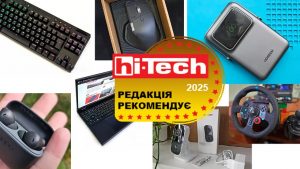
The best gaming laptops, mice for work, gaming keyboards, smartphones, and wireless headphones of 2025. Among them, we will highlight the most interesting ones and those that we can recommend buying.
Samsung announce 5 new Odyssey gaming monitors 2026 monitor Samsung
Samsung Electronics announced the release of the 2026 Odyssey gaming monitor line. The company introduced five models at once, emphasizing increased resolution, refresh rate
Michelin has created a real-time tire monitoring system car CES development
Michelin is preparing to introduce a new line of “smart” tires capable of real-time

